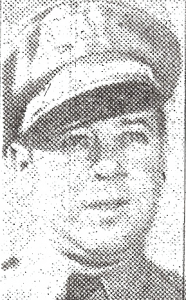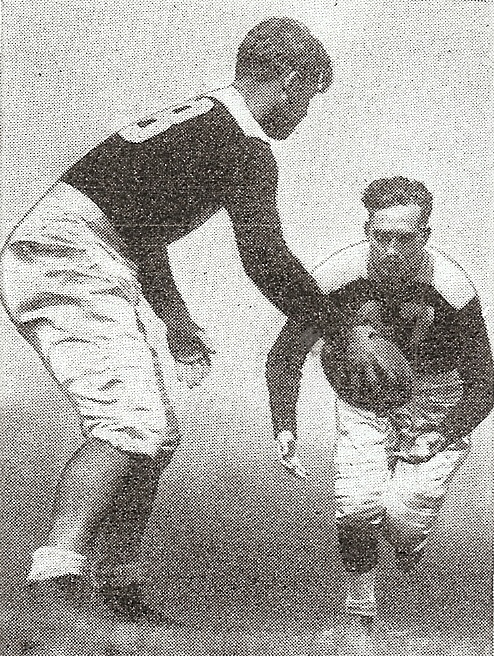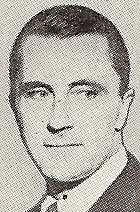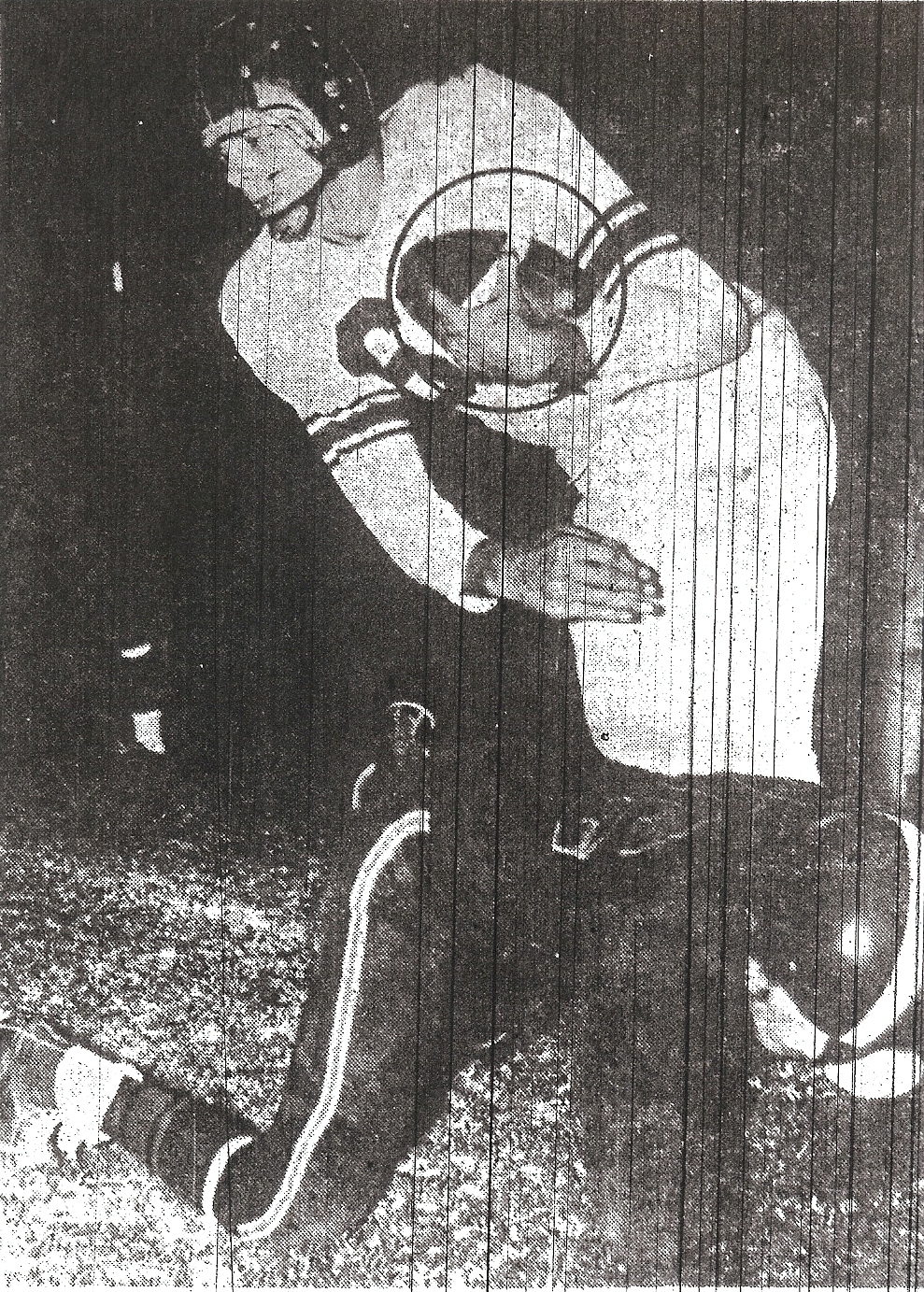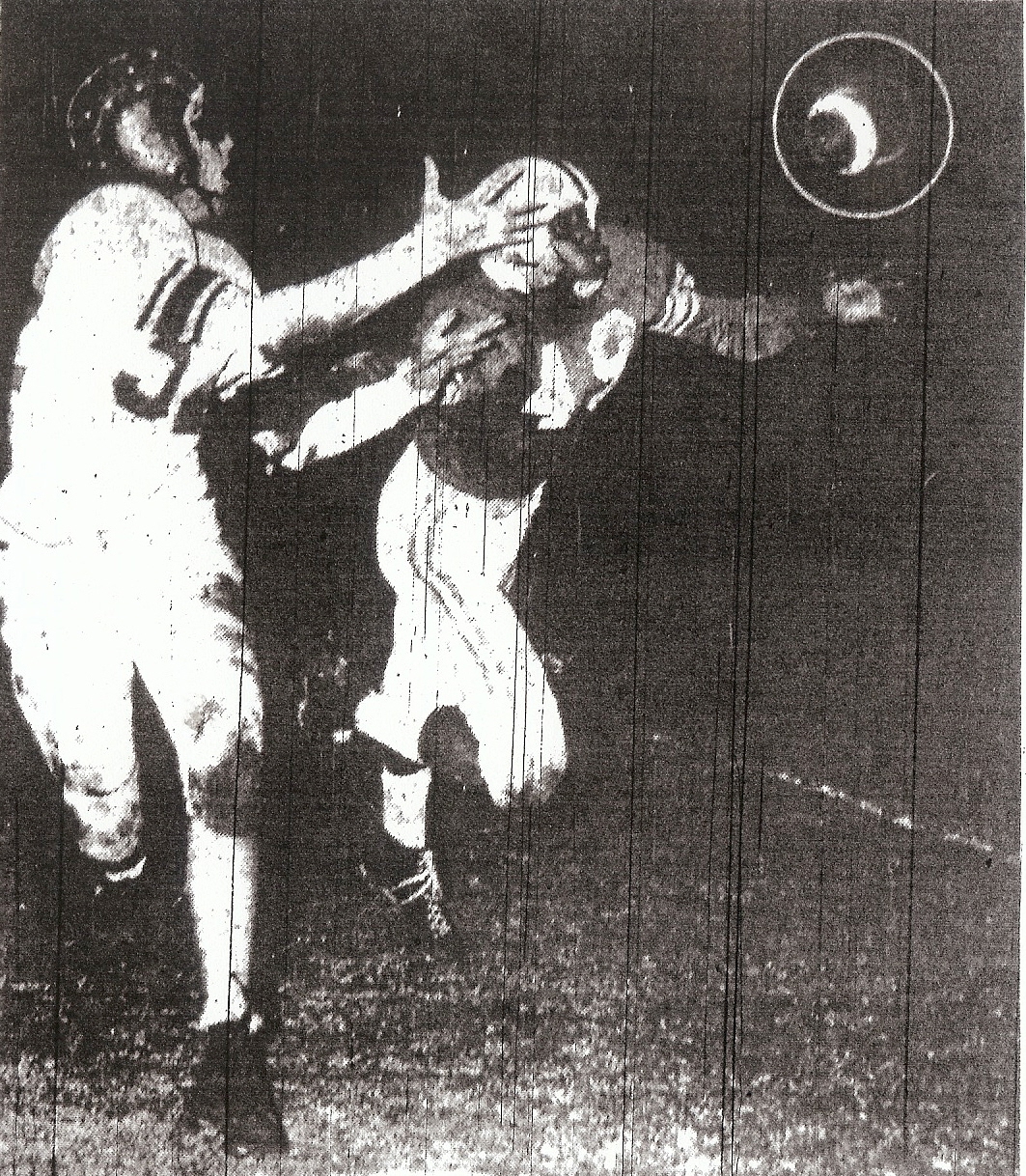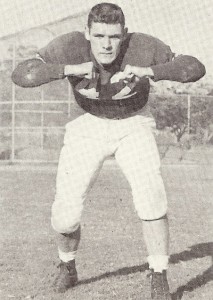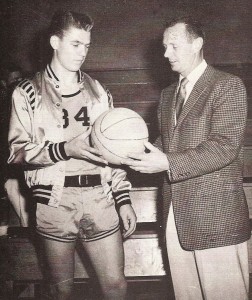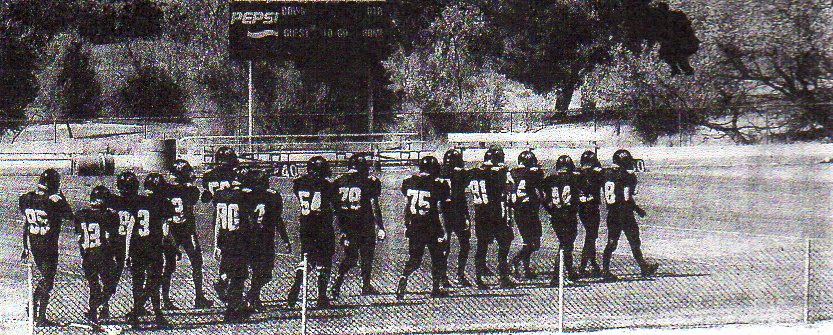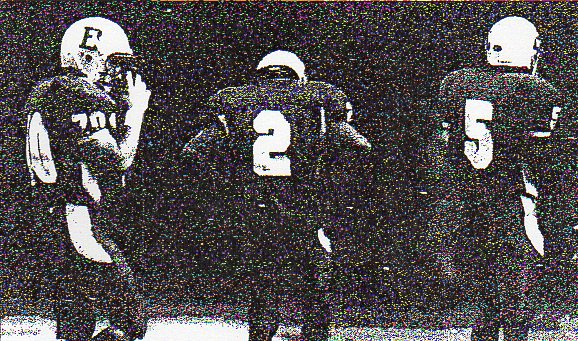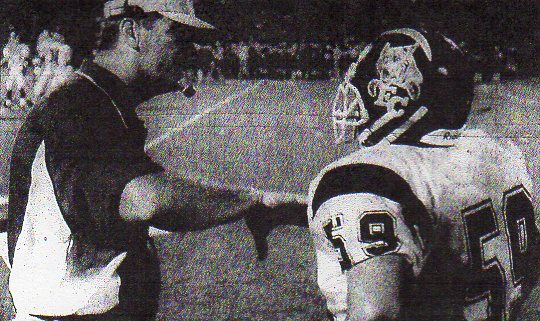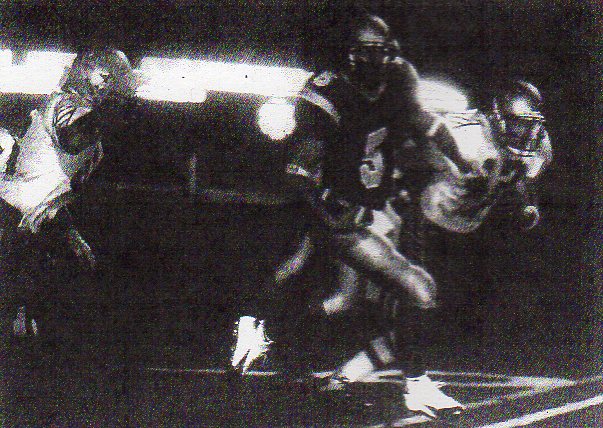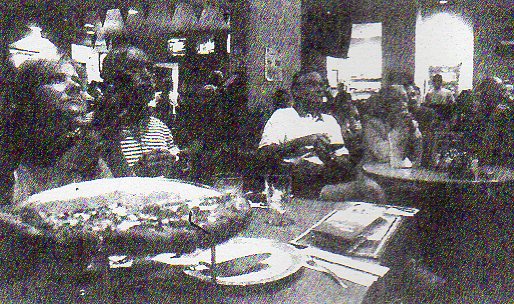1954: Cavemen Come of Age
Duane Maley, his voice hoarse and body soaked from an impromptu shower by the coach’s shouting, celebrating players, stood amid the bedlam of the San Diego High sideline in Balboa Stadium.
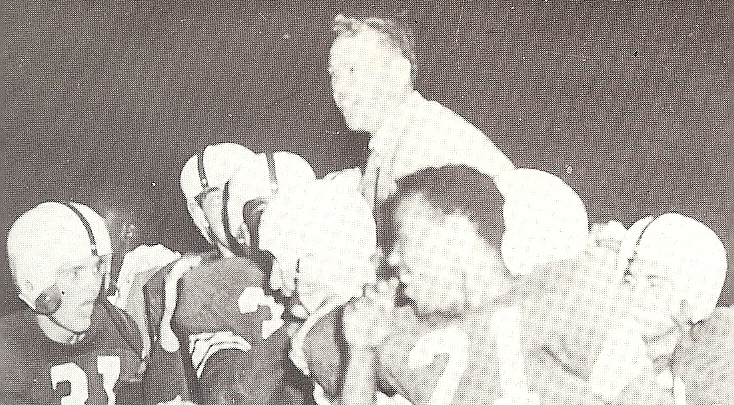
“My kids played the best football game I’ve ever seen,” said Maley after the gritty, 7-0 victory over the 7-0 Hoover Cardinals in perhaps the biggest regular-season game in the history of either school.
“It was strictly a team job,” Maley told Jerry Brucker of the Evening Tribune. “All our guys played their best ball. We beat Hoover up the gut (151 yards rushing), where they’re toughest.”
Only weeks before the headlines in San Diego newspapers seemed to say it all:
“CAVEMEN, AT LONG LAST, LOSE FAVORITE’S ROLE”
“CAVE FORTUNES AT LOW EBB”
The latter referenced a stunning, 25-0 defeat in the second game of the season against a middling Pasadena squad the Hillers had annually pushed around when the schools were members of the Coast League.
The Bullpups, eventually renamed Bulldogs, who had dropped their opener to Compton, 28-0, scored in every quarter and stunned the visitors from the Border City.
San Diego had won or shared City Prep League titles since the circuit was formed in 1950, but the 7-3 team of 1953 had graduated virtually everyone and that team had made an unexpectedly early departure from the playoffs, spanked by Anaheim, 21-7.
At 1-1 (the opener was a 7-2 victory over visiting Lynwood) Duane Maley’s team appeared ready to be had, especially after Hoover opened with a 34-20 win over Santa Monica, the reigning, two-time Southern California champion, and followed with a 20-0 victory at San Bernardino.

The Cavers’ three lettermen were end-linebacker Deron Johnson, who had been promoted from the junior varsity in ’53, halfway through his sophomore season; fullback Joe Banks, and halfback Don Strickland.
POWELL, GUMINA, AND WEST
Maley and his assistant coach, Birt Slater, talked about what needed to be done on the long bus ride back to San Diego after the loss at Pasadena.
They hadn‘t yet proved themselves but junior halfback Willie West and junior quarterback Pete Gumina were going to be stars, as would end Art Powell, Charlie’s younger brother.
Halfbacks James Grady and Leonard Kary, center Henry Wakefield, tackles Tom Collins, A.C. Mills, and Dick Szakacs, guards Wayne Melvin and Don Hiler, fullback Eldridge Cooks, and others till now unknown, also would have to rise.
Maley and Slater spent the weekend looking at their team’s now uncertain future but with their eyes fixed on a destination game against Hoover, six weeks down the road.
MOMENTUM
Essentially routine victories of 39-19 over La Jolla and 32-0 over Lincoln got the Hillers back on track. They moved to 4-1 with a 28-6 win over Point Loma that took on some added cachet considering the Pointers had scared Hoover before bowing, 20-13.
San Diego didn’t put Kearny away until the fourth quarter of a 26-13 exercise but it climbed to 6-1 with a 41-19 victory over old punching bag Grossmont as Gumina passed for three touchdowns and had two others dropped.
CARDINALS SOLID FAVORITES
San Diego had come a long way from 0-25, but oddsmakers probably would have made Hoover at least a seven or eight-point favorite in the rivals’ upcoming title showdown.
The Cavers were ready when Grady signaled their intentions by returning the opening kickoff to his 37-yard line, stopped by John Adams, who made an ankle-top tackle.
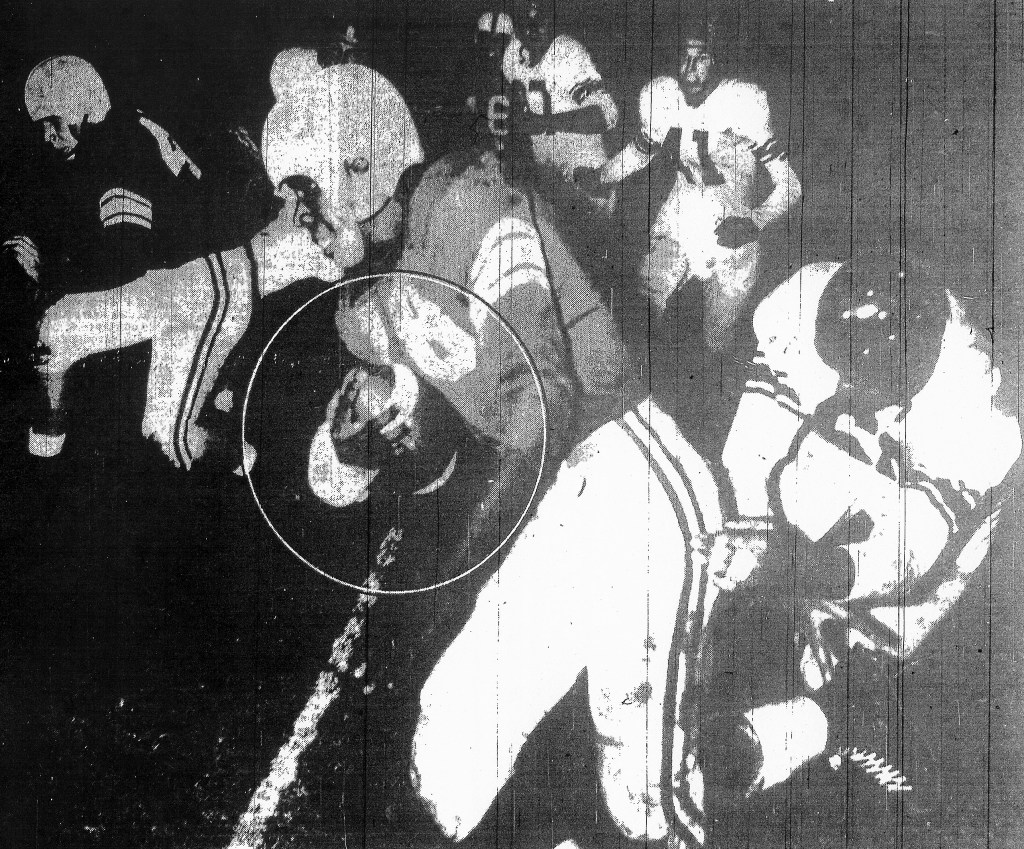
From there it was a back-and-forth struggle that wasn’t decided until the Cavers’ Joe Banks nudged over for the game’s only touchdown with a little more than six minutes to play.
LAS VEGAS, LONG BEACH WILSON FOLLOW
The victory was challenged by a chorus of Hoover complaints about the game officials, but they were drowned out by the euphoria of San Diego’s victory in this rare role as an underdog.
The Cavers weren’t finished. They went to 8-1 the next week at home with a 26-13 triumph over the 7-2 Las Vegas Wildcats, Nevada’s top team, and then opened the playoffs at home with a 26-13 victory over Long Beach Wilson.
Wilson, which upset the Hillers, 27-13, in the 1945 playoffs and with a 5-3 record this season, led San Diego, 13-7, with just under eight minutes remaining in the game. Touchdowns by West, Cooks, and Kary finally vaulted the Cavers past the pesky Bruins.
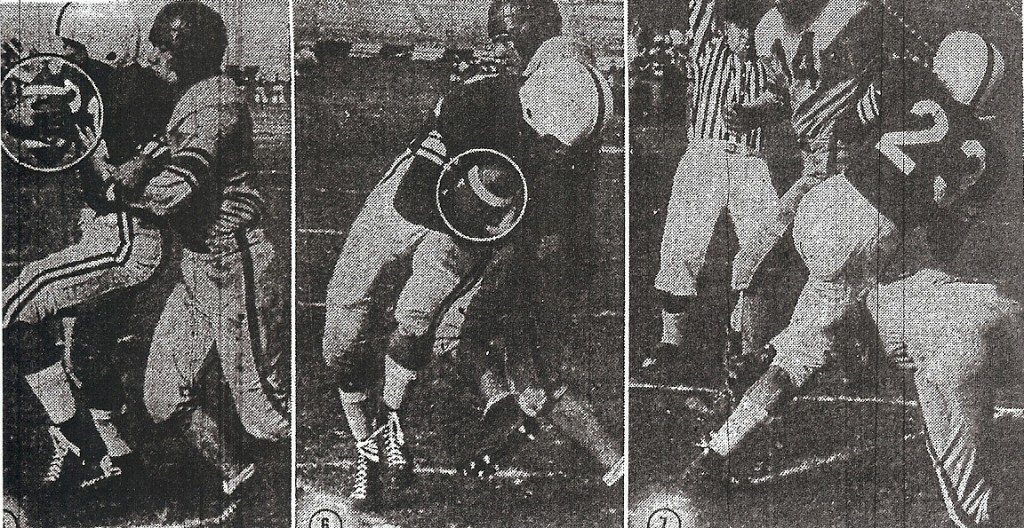
Next would be a quarterfinal test at Santa Monica, which had rebounded from the loss to Hoover and was 7-2, seeking its third straight Southern Section championship.
Trouble loomed.
Deron Johnson sustained a broken hand and Leonard Kary suffered fractured ankle in the third quarter against Wilson. Both were done for the season. Art Powell came down with a broken toe on the last play of the game but would play against the slightly favored Vikings.
Santa Monica, a 13-12 winner over the Hillers in the 1947 championship game, held on to win,14-13, as Vikings supporters flooded the field at the end of the game, more relieved than anything else.
Quarterback Lee Grosscup converted 10 of 15 passing attempts for 148 yards and a touchdown and kept the Cavers on their heels. The Vikings won the yardage battle 344-273, but the visitors rushed for 238 yards and were in position to take the lead in the fourth quarter.
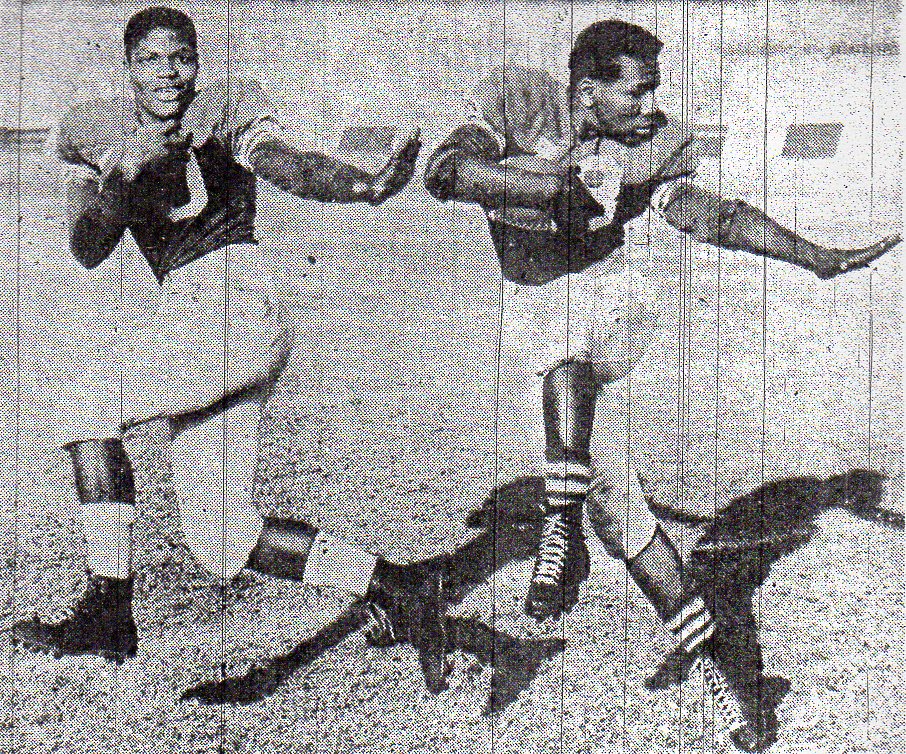
HILLERS DENIED
Trailing, 14-13 (a fumbled snap nullified one point-after-touchdown attempt on a field wet from recent rain), the Cavers began from their 20-yard line, where Gumina pitched to Banks, who lateraled to a trailing Willie West.
West weaved 60 yards downfield to the Vikings’ 20, then lateraled to the trailing Gumina, who finally was downed on the 12.
Three plays later the Cavers were back on the 14.
Gumina passed to Alden Kimbrough, Deron Johnson’s replacement. Kimbrough juggled the ball in the end zone, then saw the ball squirt from his hands.
Santa Monica rode out the clock.
Despite the loss, Maley noted that no team of his “had started with so little and come so far.”
The Cavemen already were thinking ahead to 1955.
WHEN AND WHERE?
San Diego had two representatives for the first time in the CIF Southern Section large-school playoffs, the postseason bracket having increased from 10 to 16 teams, the additional six including selected league second-place finishers or deserving free-lance teams.
Despite a crushing loss to San Diego and a struggle the following week in a 14-7 victory over start-up Lincoln, Hoover was in for the first time since winning the Bay League in 1935.
The first-round was scheduled for Friday, Nov. 26, in the middle of the Thanksgiving weekend. Southern Section commissioner Ken Fagans ruled out the possibility of two Friday night games in San Diego and what their effect would have on ticket revenue.
San Diego was booked for a Saturday afternoon contest in Balboa Stadium against Long Beach Wilson, the Coast League runner-up.
Hoover, the San Diego City League’s No. 2 team, would meet Coast league champion Compton.
Six days after the loss to San Diego and before the final regular-season game, Hoover principal Floyd Johnson and head coach Bob Kirchhoff were in Oceanside for a 9 a.m. meeting with Compton coach Gordon Orr and athletics director Keith Lee.
The Cardinals won a coin toss at the meeting and hosted a Wednesday night game the next week. Leading, 12-0, at halftime, the Cardinals fell to the Tarbabes, 20-18.

HONORS
Art Powell and John Adams made the all-Southern Section first team. San Diego’s Johnson and Hoover tackle Troy Barbee were on the third team. Another third-team choice was Compton Centennial’s Paul Lowe, later to become one of the San Diego Chargers’ all-time running backs.
Back Bob Erwin of Chula Vista and center Bill Cooper of Hawthorne were co-players of the year in the lower division. Chula Vista end Carroll Clowers was on the second team.
SIGNS OF THE TIME
Halloween rascals were not out in force, according to County sheriffs, but don’t tell that to Escondido principal Guilford (Bud) Quade.
Inventive vandals hurled light bulbs filled with paint, damaging Quade’s automobile, and “grease bombs” were tossed at his home.
This Bud definitely wasn’t for the Cougars’ boss.
HORNETS’ GYM APPROVED
The San Diego Board of Education accepted the low bid on construction of an auditorium-gymnasium at the new Lincoln High after having delayed action when the bid turned out to be $12,409 in excess of the estimate.
Chamco Construction won the bid at $378,669, which reconciled at $13.46 a square foot. The same contractor won a bid for a similar gymnasium-auditorium at Mission Bay for $10.10 per square foot.
Assistant superintendent George Geyer suggested accepting the Lincoln offer because it would take a year to redesign the building and call for new bids.
PIGSKIN OR RUBBER…NO MATTER
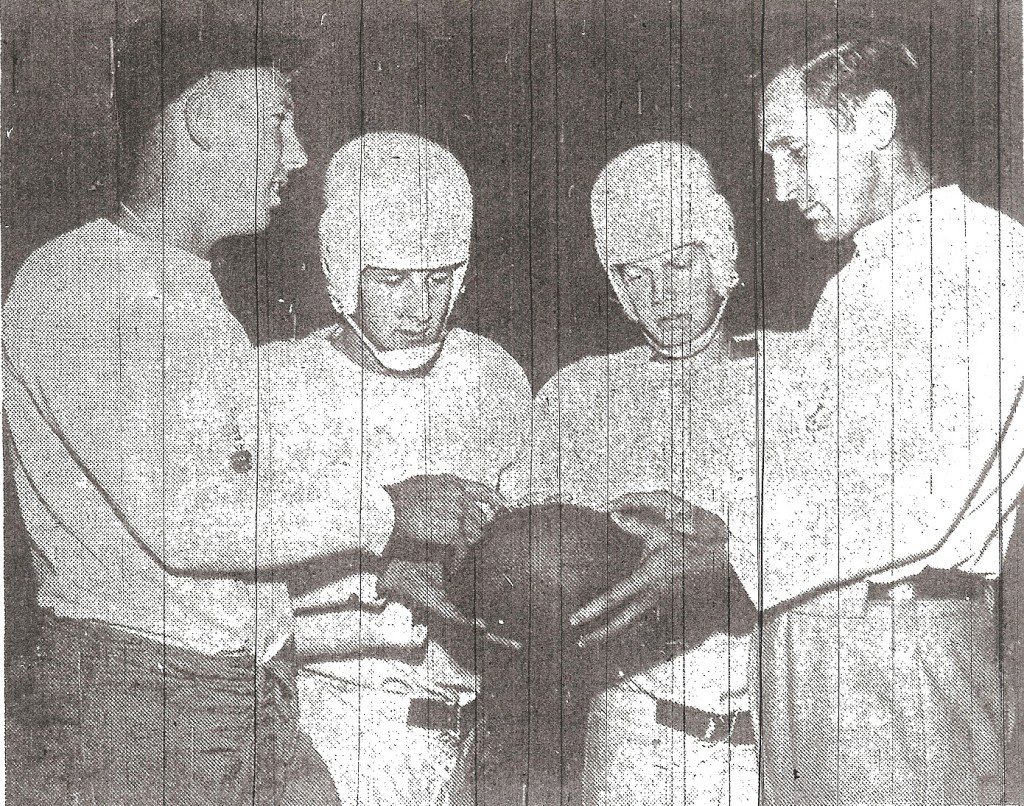
Oceanside won the inaugural Avocado League championship by virtue of a 0-0 tie with old rival Escondido on a field left sloppy from rains.
The teams had prepared for an off track by introducing an easier-to-grasp rubber football, similar to that used by teams from the Eastern part of the country when bad weather hits in the late fall.
But as Union writer Dave Gallup pointed out, fumbles and intercepted balls were caused by a slick ball.
Escondido had 93 yards total offense, Oceanside 31.
SORRY, WRONG NUMBER!
Lincoln halfback Sam Goldstein was The San Diego Union City Prep League back of the week after he led the Hornets to their first ever victory with two touchdowns in a 19-0, opening-game shutout at Escondido.
Identity theft? Actually, two or three.
As noted in a much smaller story the next day:
Goldstein didn’t score on a 35-yard pass-run play with quarterback “Don” Seeley or on a 75-yard pass play later in the game.
Doyle Seeley was the quarterback in question, but it was Percy Campbell who threw the two touchdown passes.
And it was halfback Charlie Cox who scored the touchdowns.
The Union declared the mistaken identity on Goldstein-Cox was due to a switch in jersey numbers.
But what about Don, er, Doyle Seeley and Percy Campbell? They didn’t change jersey numbers.
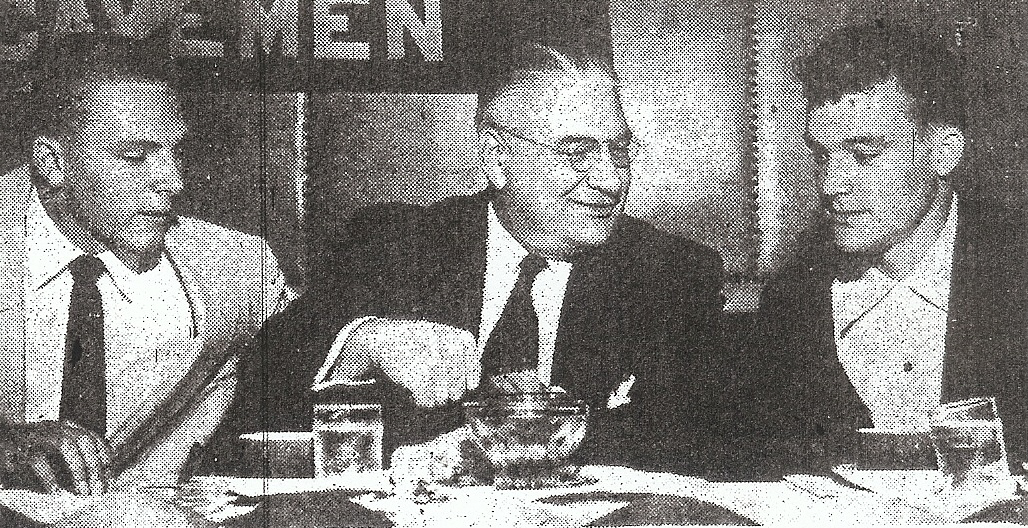
22-POINT LOSS IS IMPROVEMENT
Grossmont’s 41-19 loss to San Diego actually qualified as a moral victory.
–Grossmont was winless in 11 games against Cavers’ varsity dating to 1922, the season which ushered in the series with a 40-7 San Diego victory.
–The teams didn’t meet again until 1943. From that season through 1949, Grossmont was outscored, 128-7, in five losses.
–Grossmont was on the sore end of a 67-0 score in 1953.
–Eight of San Diego’s 11 wins were by shutout.
–The 19 points scored against the Cavemen this season almost equaled the 21 Grossmont had scored in the previous 33.
Grossmont also had a 1-4-1 all-time record against San Diego’s Reserves, B teams, or the split squad of the World War II 1942 season.
FUTURE CHARGERS
First-year Compton Centennial was a surprising winner in the Southern Section playoffs, defeating Glendale Hoover, 12-6. Single-wing tailback Paul Lowe completed a 50-yard touchdown pass on the final play of the game for the victory.
Santa Monica and Compton, teams which eliminated San Diego and Hoover, were themselves beaten in the semifinals. The Cavers and Cardinals still ranked among the best of the 227 schools competing in the CIF Southern Section.
QUICK KICKS
Don Giddings was the veteran Point Loma coach…Don Giddings also was the name of the horse that ran out of the money at Jamaica Racetrack on Long Island, N.Y….Ray Blasingame, who also answered to “Boomer” and “Blaster”, Point Loma’s 1953, all-league end, was an all-league fullback in 1954…21,000 persons were in Balboa Stadium as the East (La Jolla, Hoover, Kearny) topped the West (Lincoln, Point Loma, San Diego), 18-13, in the CPL carnival…6,000 jammed Spartan Stadium in Chula Vista for the Metropolitan League carnival, matching the Grossmont school district league schools against teams from the Sweetwater district…the Avocado League got into the carnival spirit two weeks into the season, when 4,000 filled Escondido’s new, Vallecitos Stadium to watch the inland schools, Escondido, Fallbrook, and Vista, defeat the Coastals, San Dieguito, Oceanside, and Coronado, 21-13…San Diego’s Art Powell wore jersey number 49, same as worn by brother Charlie five seasons before…Mar Vista, enrollment 410, bailed from the Metropolitan League and would go into the Avocado loop in 1955…the Split T formation favored by college powerhouse Oklahoma was en vogue…La Jolla finally gave up the single wing for the Split T under second-year coach Frank Smith….University of California coach Lynn (Pappy) Waldorf was guest of honor and speaker when the North Park Kiwanis honored the Hoover and San Diego squads with a postseason dinner at the Imig Manor Hotel on El Cajon Boulevard….
